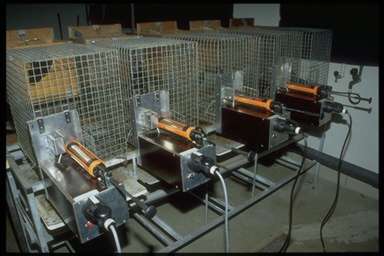
Measuring behaviour: let the animals do all the work
E.L. Decker, E.S. Frimer, S.W. Hansen and M. Bak Jensen
Department of Animal Health and Welfare, Danish Institute of Agricultural Sciences, Research Centre Foulum, Tjele, Denmark
Science
The behavioural needs of farm animals may be quantified by demand functions
generated by operant conditioning techniques. When using operant conditioning
to quantify behavioural needs, the animals are required to perform an operant
response (work) to get access to perform certain behaviours (reward). Typically,
animals are required to press a lever for food rewards, but some operant responses
may be more closely related to the reward than others. It has been suggested
to use different responses for different rewards. In the set-up presented here
the aim was to investigate the effect of response type on the demand for food
in mink. The demand function is the change in the number of rewards as a function
of work requirement. Chain pulling resulted in a demand function with a steeper
slope than lever pressing (p<0.001), the type of operant response influenced
the demand function. This means that it is necessary to use the same type of
response when comparing demand curves for different types of behaviours.

Figure 1. Mink at work.
Technology
There is some "operant conditioning" equipment for studying the behaviour of
rats on the market. However, we wanted to study farm animals full-time in their
home environment. Designing the equipment for this required some lateral thinking.
Take the feeder for example. As the feed had to be the standard "fish paste"
feed, we used a caulking gun, eminently suitable for delivering pastes. For
driving the feeder we used a windscreenwiper motor. The real problem was designing
the levers and chains. How big, how long, what material, what force for pushing
or pulling. Luckily technologists are allowed some anthropomorphism. Using this,
we settled on a design that proved quite suitable, except for the choice of
aluminium for the levers: mink love chewing them.

Figure 2. Rear view of four chambers, showing the feeders.
Controlling the equipment
proved to be quite simple, using a PC equipped with a "Computer Boards PDISO8"
I/O device (8 sensors to register actions, 8 switches to control). The basic
principle for controlling the equipment and collecting the data was to do just
that, controlling and collecting and no more. The PC showed only basic operation
figures, number of presses, rewards, time since last press, and a monitor showing
the reaction time of the PC (0.02 s, running 4 feeders).
As for data collection, all events were time stamped and recorded as plain text.
Calculations, including reporting on the daily "work" of the mink, were carried
out on a "real" PC using a standard data treatment package (SAS).
Conclusion
The method of controlling the equipment and collecting the data can be used
for almost every kind of equipment and almost any kind of animal. The next part
of the project will be to establish demand functions for different behavioural
needs besides feeding, like the use of a nestbox, access to straw, etc.
Poster presented at Measuring Behavior 2000, 3rd International Conference on Methods and Techniques in Behavioral Research, 15-18 August 2000, Nijmegen, The Netherlands